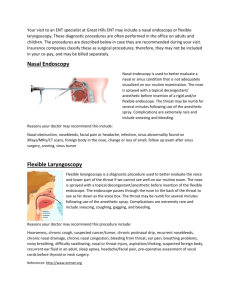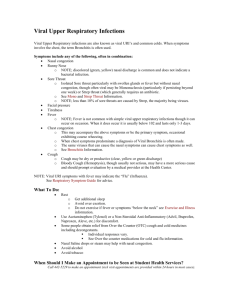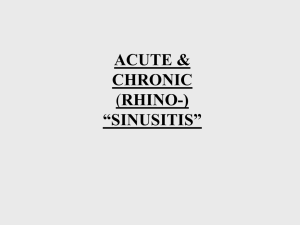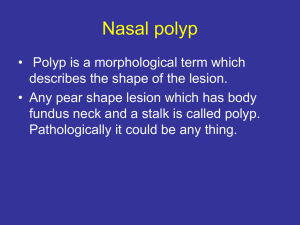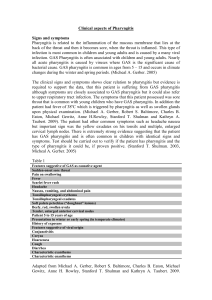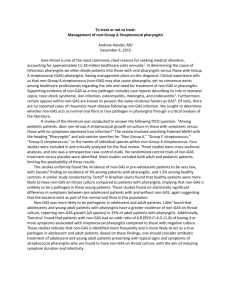Upper Respiratory System B& S Ch 20
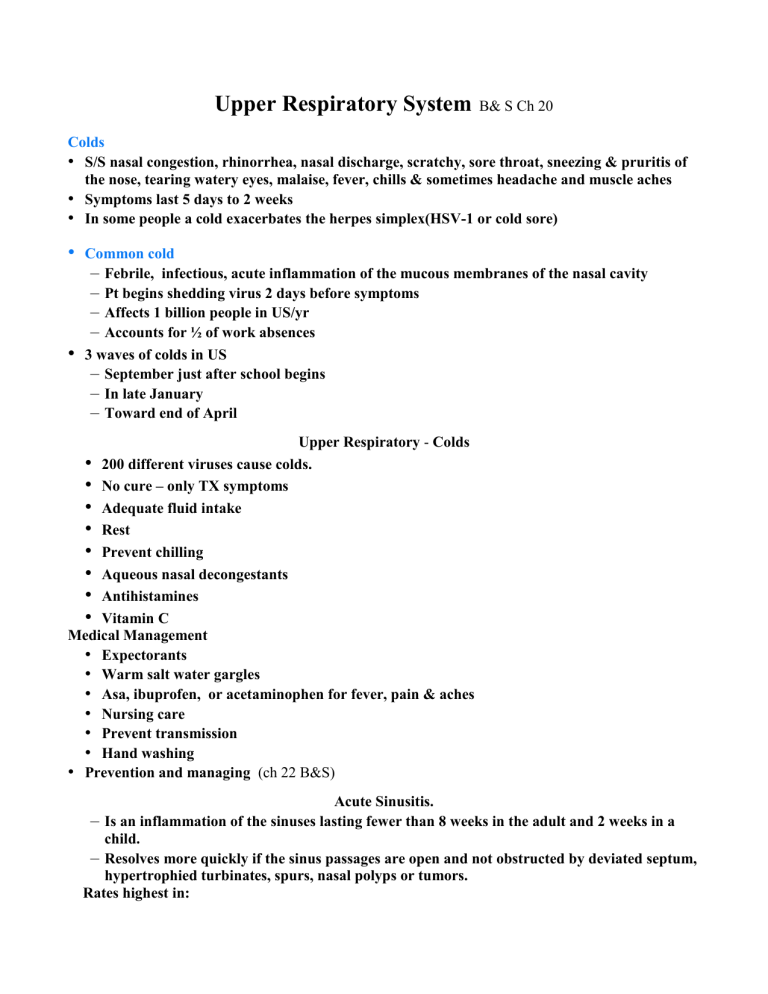
Upper Respiratory System
B& S Ch 20
Colds
•
S/S nasal congestion, rhinorrhea, nasal discharge, scratchy, sore throat, sneezing & pruritis of the nose, tearing watery eyes, malaise, fever, chills & sometimes headache and muscle aches
•
Symptoms last 5 days to 2 weeks
•
In some people a cold exacerbates the herpes simplex(HSV-1 or cold sore)
•
Common cold
–
Febrile, infectious, acute inflammation of the mucous membranes of the nasal cavity
–
Pt begins shedding virus 2 days before symptoms
–
Affects 1 billion people in US/yr
– Accounts for ½ of work absences
•
3 waves of colds in US
–
September just after school begins
–
In late January
–
Toward end of April
Upper Respiratory - Colds
•
200 different viruses cause colds.
•
No cure – only TX symptoms
•
Adequate fluid intake
•
Rest
•
Prevent chilling
•
Aqueous nasal decongestants
•
Antihistamines
•
Vitamin C
Medical Management
•
Expectorants
•
Warm salt water gargles
•
Asa, ibuprofen, or acetaminophen for fever, pain & aches
•
Nursing care
•
Prevent transmission
•
Hand washing
•
Prevention and managing (ch 22 B&S)
Acute Sinusitis.
–
Is an inflammation of the sinuses lasting fewer than 8 weeks in the adult and 2 weeks in a child.
–
Resolves more quickly if the sinus passages are open and not obstructed by deviated septum, hypertrophied turbinates, spurs, nasal polyps or tumors.
Rates highest in:
–
South and Midwest
–
Among carpenters, leather tanners
–
Manufacturers of paint, dye and solvents
•
Often results after upper respiratory infection or allergic rhinitis.
•
Nasal congestion leads to obstruction of the sinus cavities providing a medium for bacteria growth.
•
Tooth infection is associated with sinusitis .
Symptoms
•
Symptoms
–
Pain & pressure over sinus area
–
Purulent nasal secretions
•
Assessment
–
H&P
–
CT scan of sinuses to R/O tumor, fistula or allergy
•
If left untreated may lead to potentially life threatening complications such as
– Meningitis
–
Brain abscess
–
Ischemic infarction
– Osteomyelitis
–
Orbital cellulitis
•
Medical management
– TX infection
–
Shrink nasal muscosa
–
Relieve pain
Sinusitis
•
Antimicrobial agents of choice are amoxicillin & augmentin for 7 – 10 days
•
If allergy to penicillin give Bactrim DS, Septra DS.
•
Oral/ topical decongestants
•
Heated mist
•
Saline irrigation
•
Hot wet packs over sinus area
•
Pt teaching
•
Fever, severe headache & nuchal rigidity are signs of potential complications
Chronic Sinusitis
•
Usually caused by narrowing or obstruction of opening of the sinuses
•
S/S
–
Cough (post nasal drip)
– Fatigue
–
Chronic hoarseness
–
Nasal stuffiness
– Headaches
–
Facial pain
Medical management
–
Antibiotics for 21 days
–
May use surgical intervention
–
Same interventions as for acute sinusitis
Rhinitis
•
Rhinitis (B&S 589)
•
Inflammation of the mucous membranes of the nose
•
Classified as: Infections, Allergic, Nonallergic
•
Common causes: upper respiratory infections, from viruses, bacteria, fungi
•
Less common causes: foreign bodies & other.
•
Clinical manifestations
– Rhinorrhea
–
Nasal congestion
–
Nasal discharge
•
Medical management
–
Depends on the cause
- Sneezing
- Headache
- Nasal itchiness
–
TX infections with antimicrobial
– If allergy is the cause, identify allergens
•
Avoid allergens
•
Desensitizing immunizations and corticosteroids
•
Medications for symptom relief
•
Antihistamines
•
Oral decongestants
•
Intranasal corticosteroids
•
Saline nasal sprays
Acute Pharyngitis
•
A febrile inflammation of the throat caused by a virus 70% of time
•
Called strep throat when caused by group A streptococci
•
Viral infections usually subsides in 3 – 10 days
•
Strep throat more severe illness with dangerous complications
– Sinusitis
–
Otitis media
–
Peritonsillar abscess
–
Mastoiditis, rheumatic fever, & nephritis
•
Assessment
•
Streptococci antigen screening
•
Streptolysin titers
•
Throat cultures
•
Fiery-red pharyngeal membrane
•
Enlarged, tender lymph nodes
•
Fever
•
Malaise
•
Sore throat
What Are Some of the Dangerous Complications of Strep Throat?
Sinusitis,
Rheumatic fever
Otitis media,
Nephritis
Peritonsillar abscess;
Mastoiditis
Management of Acute Pharyngitis
•
Viral pharyngitis – treat symptoms
•
Bacterial Pharyngitis – treat with antimicrobials (penicillin or erythromycin) or cephalosporins for 10 days
•
Pain meds- ASA or acetaminophen /w or w/o codeine
•
Antitussive
Nursing interventions for acute pharyngitis.
•
Diet – fluids up to 2 – 3 liters/day
•
Bed rest
•
Proper disposal of tissue
•
Observe for rash as pharyngitis may precede other communicable diseases
•
Warm, saline gargles
•
Ice collar
•
Mouth care
Chronic Pharyngitis
•
Common in adults who:
–
Work or live in dusty surroundings
– Use voice to excess
–
Have chronic cough
– Use alcohol & tobacco habitually .
•
C/o:
–
Constant sense of irritation or fullness in the throat
–
Mucus
– Difficulty swallowing
•
Medical management:
–
Relieve symptoms
–
Avoid exposure to irritants
–
Correct problems contributing to chronic cough.
–
Short-term use of nasal sprays
–
Antihistamine decongestants
Tonsillitis and Adenoiditis
•
Symptoms: Sore throat, fever, snoring, difficulty swallowing
•
Enlarged adenoids can cause
–
Mouth breathing - Earache
–
Frequent colds
–
Foul smelling breath
- Bronchitis
- Voice impairments
–
Noisy respirations
•
Assessment
•
Tonsillar site is cultured to identify bacterial infections
•
Treat with appropriate antibiotic therapy
•
Treat symptoms
–
Warm saline gargles
–
Pain meds
–
Ice collar
–
Tonsillectomy if recurrent bouts of tonsillitis
–
Some controversy over tonsillectomies
•
Nursing care for post op tonsillectomy
•
Observation for hemorrhage
•
Turn head to side to facilitate drainage
•
Remove oral airway only when swallowing reflex has returned
•
Ice collar
•
Basic and tissues for expectoration of blood
•
Nursing care.
•
Notify the physician immediately if:
•
Pt vomits large amts of coffee ground emisis or
•
If vomits frequent small amts of bright red blood or
•
Pulse rate & temp rise and pt is restless.
•
A gauze , light, mirror, & curved hemostats should be available.
•
If no bleeding can give water and ice chips as soon as pt desires.
•
Surgery is done as out-patient.
•
Instruct family that hemorrhage can occur in first 12 – 24 hours. Instruct on S/S of hemorrhage.
•
Alkaline mouthwash & warm saline mouth rinses are helpful in controlling mucus and bad breath.
•
Teach family that a stiff neck, sore throat and vomiting may occur in 1 st 24 hours pot-op.
•
Liquid or semi liquid diet for several days is recommended.
Laryngitis
•
Inflammation of the larynx
•
Caused by:
–
Voice abuse
–
Exposure to dust, chemicals, smoke & pollutants
–
Respiratory tract infections
•
S/Sx
•
Hoarseness
•
Aphonia – complete loss of voice
•
Cough
•
May be complication of chronic sinusitis & chronic bronchitis
Laryngitis - Medical Management
•
Voice rest
•
Avoid smoking
•
Rest
•
Inhalation of cool steam
•
Treat underlying cause
•
Topical corticosteroids (Vanceril)
Obstruction (B&S 410)
•
SLEEP APNEA – cessation of air flow during sleep
•
Pathophysiology 3 types
–
Obstructive – lack of airflow due to pharyngeal occlusion
–
Central – simultaneous cessation of both air flow and respiratory movements
–
Mixed – a combination of central and obstructive apnea within one apnea period
Obstructive Sleep Apnea
•
Usually occurs in men
•
Especially older &/or over weight men
•
Cigarette smoking is a risk factor
•
Defined as frequent and loud snoring & breathing cessation for 10 seconds or more for 5 episodes per hour, followed by awakening abruptly with a loud snort as blood O
2
drops
•
From 5 to several hundred apneic periods can occur per night
•
Other symptoms are
– Excessive daytime sleepiness
–
Morning headache
–
Intellectual deterioration
– Behavioral disorders
–
Impotence
- Sore throat
- obesity
- personality changes
- enuresis
•
Obstruction might be caused by reduced diameter of upper airway.
•
Changes during sleep may predispose pt to upper airway collapse with the small amounts of negative pressure generated during inspiration.
•
Diagnosis made based on history and polysomnographic tests
•
Obstructive Sleep Apnea
•
Medical management
•
In mild cases instructed to avoid alcohol 7 meds that depress the upper airway & to lose weight
•
In more severe cases with hypoxemia with severe CO
2
retention, TX includes continuous positive pressure airway or believe positive pressure therapy with O
2
•
Surgical procedures.
•
Uvulopalatopharyngoplasty may be performed.
•
Tracheostomy is last resort.
•
Protriptyline at bedtime increases respiratory drive and muscle tone.
Epistaxis
•
Nose bleed
•
Common site is anterior septum
Epistaxis - Associated Causes
•
Trauma
•
Drugs
•
Blood dyscrasias
•
Low humidity
•
Deviated septum
- Infection
- Cardiovascular diseases
- Nasal tumors
- Foreign body
Epistaxis - Treatment
•
Pt sits upright with head tilted forward
•
Pinches soft outer portion of nose against septum for 5 – 10 minutes
•
Silver nitrate
•
Gelfoam
•
Electrocautery
•
Vasoconstrictors such as adrenaline (1:1000), cocaine (0.5%) & phenylephrine
Fractures of the Nose
•
Most fx do not cause serious problems but can interfere with breathing after they heal.
•
A serious fx can cause a hematoma that can abscess and destroy cartilage if not drained.
•
Fx of cribriform plate may cause leaking of CSF.
•
Bleeding internally or externally
•
Swelling of the soft tissue
•
Deformity
•
Inspection & Palpation
•
X-ray
•
Management
–
Control bleeding with cold compresses
–
Pt referred to specialist 3 – 5 days after injury
–
Surgically reduced 7 – 10 days after injury
Nursing management
•
Apply ice packs 20 minutes 4 times per day
•
Mouth rinses
Cancer of the Larynx
•
Represents less than 1% of all cancers
•
8 times more common in men
•
More common in people 50 – 70 yrs old
•
10,600 new cases in US per yr
•
4,200 people die from it per yr
SYMPTOMS of Cancer of the Larynx
•
Hoarseness with cancer near glottis
•
Pain or burning in throat when drinking hot liquids
•
Lump near neck
Later symptoms
•
Difficulty swallowing or breathing
•
Unilateral nasal obstruction or discharge
•
Persistent ulceration
•
Foul breath
Assessment
•
H & P
•
Exam of head and neck
•
Indirect laryngoscopy follower by direct laryngoscopy
•
Biopsy
•
CT scan
•
MRI
Cancer of the Larynx
•
Tumor is staged to determine TX
–
T (tumor) or extent of primary tumor
– N (node) or location & extent of nodal involvement
–
M (metastasis) or spread of tumor outside sit of origin
•
Treatment options include
•
Radiation
•
Chemotherapy
•
Surgery (laryngectomy)
–
Laryngectomy
•
Partial
•
Supraglottic
•
Hemilaryngectomy
•
Total laryngectomy
•
Speech therapy
•
A laryngeal communication
1. Esophageal speech
2. Artificial larynx
3. Tracheoesophageal – a valve is placed in trach stoma to divert air into esophagus and out of mouth. Fitted with a prosthesis when stoma healed

